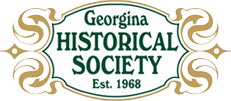Click to Download the PDF
Download the Word Doc
President’s Message
Welcome to our February, 2019 edition of the Georgina Historical Society newsletter. Our General Meeting on January 15th was well attended. Enthusiastic members shared their family artifacts. Fascinating souvenirs from WW1, old Eaton’s catalogues, old publications about the royal family, jewellery, ornamental decorations from horse’s bridles, old carefully-crafted seashell pictures, milk bottles from Briars Dairy, old university papers, an authentic Newfoundland fisherman’s telescope and an early device to relieve arthritic pain were brought and shared by the members present. Even more interesting than the articles were the stories that accompanied them. Be sure not to miss any future “Bring and Brag.”
At our Board of Director’s meeting we formed some committees in order to better accomplish the goals of the Georgina Historical Society. The committees are as follows: General Meetings, for planning and organization; the Newsletter, for editing and publishing it.
Events including Harvest Fest, for their organization and planning; Archives, to assist in the management of our historical archival materials; Fund Raising and Membership, to oversee and plan fund raising events and promote membership; and Website, for the management and updating of information on our website. We are looking for member participation on the various committees and welcome your input, skills and knowledge. Feel free to contact a Board member from the list on the last page of this newsletter.
Our next General Meeting will be on Tuesday, February 19 at 7pm at the Police Station. We will be showing “Postcards From Olde Georgina” that we have been collecting. See you there!
~ Tom Glover
Winfield Hotel – By Karen Wolfe
In researching the story of Pefferlaw’s bootlegging legacy I stumbled across a little-known artifact – the Winfield Hotel. Winfield Hotel was built in the early 1860s and was owned by James and William Winfield. Township of Georgina council minutes from February 15, 1868 suggest that James Winfield’s application to renew his tavern license was granted even though he was charged with selling whiskey on a Sunday on January 26, 1868. Records from that era also confirm that the Winfield Hotel was the venue for the April 1868 council meeting.
An early map of the area shows that the property was once owned by Robert Johnston brother to Pefferlaw’s founder, Captain William Johnston. The hotel was located on the south side of what is now known as Old Homestead Road on the west side of the Pefferlaw River. Considered to be one of the first hotels built in the area, the business catered to river drivers and loggers as they moved their timber down the Pefferlaw River to Johnston’s mill at the dam. Although the hotel was strategically located to accommodate the needs of the logging customers, it was also in a convenient location for travelers coming and going to Sutton or Pefferlaw from Udora and Uxbridge.
At that time Old Hubbard Road (which is no longer in use) ran south from Pefferlaw Road and connected with Old Homestead Road just about where the Winfield Hotel was located. It continued south through the current Woodlands Subdivision and the York Regional Forest to what if now known as Ravenshoe Sideroad.
The Winfield Hotel eventually closed and it was converted into a private residence. Many people still remember its claim to fame as the home of a reputed bootlegger in the middle of the last century.
The old Winfield Hotel was recently purchased by Jordan Dysart, a young Pefferlaw man who is renovating the structure and was delighted to learn of its historical significance to Pefferlaw. (It is the third house west of the river on the south side of Old Homestead Road.) During the renovations, Jordan and his father came across some interesting artifacts buried deep beneath the old summer kitchen. They found a perfectly mummified cat which is now at the University of Toronto being carbon dated and a number of old bottles and confectionary items.
Sources:- Originally written by Karen Wolfe for the Pefferlaw Post, October 24, 2008, the article was used in the Doors Open Georgina: Pefferlaw section from the Doors Open 2010-2013 publication from the library in the offices of the Georgina Pioneer Village.
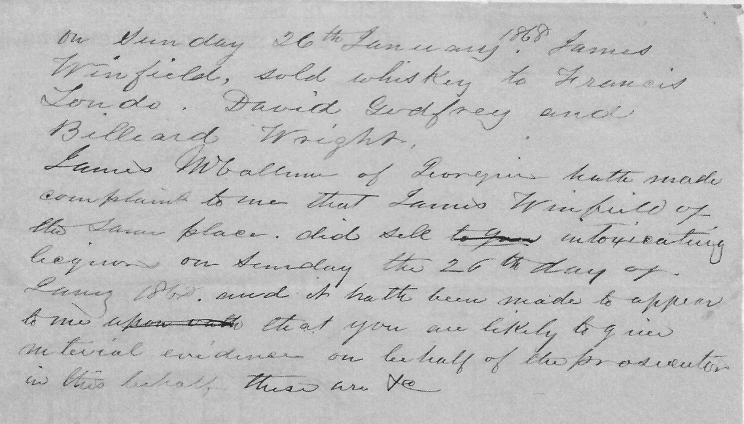
This handwritten note reads as follows: “On Sunday 26th January 1868 James Winfield, sold whiskey to Francis Londo, David Godfrey and Billiard Wright. James McCallum of Georgina hath made complaint to me that James Winfield of the same place did sell intoxicating licquors on Sunday the 26th day of Jany 1868 and it hath been made to appear to me that you are likely to give the material evidence on behalf of the prosecutor in this behalf these are &c”
Tiger Dunlop Builds Trail – By Terry Carter
As a young British army officer, Dr. William Dunlop, later to be known to history as “Tiger” Dunlop, craved excitement and often volunteered for special duty.He had completed medical studies at universities in both Glasgow and London and then qualified as an army surgeon.
As a 23-year-old Assistant Surgeon in the 89thFoot in 1814, he volunteered to accompany a party setting out on one of the Commander-in-Chief’s pet projects, to build a road through the wilderness from the head of Lake Simcoe to Penetanguishene, thus establishing interior communication between Lake Ontario and Georgian Bay. The account he wrote later tells of his adventure with the road-building party.
This was the road which was the key to the Newmarket area’s first wave of prosperity. Built to facilitate construction of a dockyard at Penetanguishene, it increased military and commercial traffic on Yonge St. and Newmarket’s merchants profited by the increase. Farmers too sold supplies, billeted troops, and used their teams and wagons to move supplies up to the Holland Landing port.
It was early December, 1814, when the government decided it needed the road and dispatched a company of Canadian Fencibles and about an equal number of militia from the area to “one of the northernmost points in Canada” to cut the trail.
The troops headed for the east side of Lake Simcoe, probably Roches Point, where the old Indian trail from Newmarket met the lake. It was at that time being used by the British army as a shipping route during warm months. When they arrived, they found the ice on the lake too thin to support them, so they took up residence in farmhouses and waited.
“In two days it was considered practicable to cross, and I volunteered to try it,” wrote Dr. Dunlop. “I equipped myself with a long pole, with a chisel at the end of it, to try the ice with, and an axe slung across my shoulder, and skated across, about 12 miles.”
He decided the ice would hold for the men if they marched in extended order, and on his return the march was ordered for the next morning.
“Next morning,” reports the doctor, “the men were drawn out at the point at which it was considered the most eligible for getting on the ice; but the moment we were ready to start, a noise, like that of very loud thunder, was heard, which ran round the lake, and across it; and in an inconceivably short time, the whole ice was broken into fragments, some of some acres in extent, others of only a few yards. What the cause of this phenomenon could be, I never could form even a probable conjecture of, for there was no visible rise or fall of the water; but I was told by the inhabitants of the neighbourhood that they had more than once seen the same thing before.”
The farmers advised that the troops wait until the next day. The ice would reform and water rising over the piece and freezing would make it stronger than ever, they said. But the British officers were afraid of getting caught by storms on the wrong side of the lake.
Here’s how Dr. Dunlop relates that crossing: “After due deliberation, it was resolved, that having a coil of rope with us, it should be stretched along, and each take hold of it, and drag his hand sleigh, on which was his knapsack and provisions, as well as divers tools, implements, and stores, requisite for the expedition. In this guise we proceeded across the lake; the disasters were numerous but none of them serious. A fellow in stepping on a facture of ice in the shape of the letter V, would plunge in and then be dragged out again by his comrades, amidst shouts and laughter. In this mode we progressed for upwards of six hours, until we reached the opposite side, where a huge pile of logs was kindled; a space was swept clear of snow, and we sat down to a late dinner.”
Next day, they started building road.
As the road neared completion, the party promised itself a pleasant summer of recuperation on the shores of Georgian Bay at the army’s expense. Dunlop went ahead to cut a clearing with a beach and a view, when “all our anticipations were set aside by the arrival of the appalling intelligence that peace had been concluded … this showed us half-pay staring us in the face.”
Dr. William “Tiger” Dunlop, British army officer, medical man, legislator, and land baron –was a man who left an indelible mark on the history of Upper Canada. He is best known for his overseeing development and his autocratic rule of the Huron Tract for the Canada Company.
Sources:
Graham, W.H., The Tiger of Canada West, Clarke, Irwin & Company Limited, Toronto, 1962.
Dunlop, William, Tiger Dunlop’s Upper Canada,New Canadian Library, McClelland & Stewart, 1967
Mann Cemetery
166 Queensway North, Keswick
The Mann Cemetery is purportedly the site of the original Christian Church. The 1906 obituary of John Morton Sr. states: “The first church was established one mile north of Keswick in a schoolhouse in what is now known as Mann’s Burying Ground.”
The Mann Cemetery was formerly called the Christian Church Burying Ground, the Sprague Cemetery, and the Keswick Burying Ground. The earliest burial (according to the remaining markers) is that of Darius Mann Sr. who with Mary Stogdill brought the Christian Church to Keswick. Darius died in 1826.
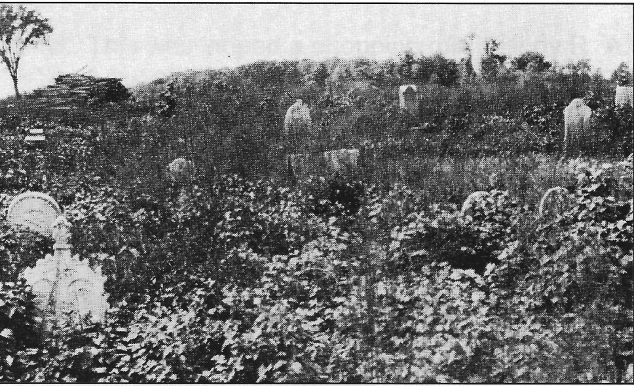
The Mann Cemetery contains some of Keswick’s oldest families. Some of those buried here are the families who lived in some of the homes featured on this year’s Doors Open Georgina tour (2013 – as published in a Doors Open 2010-2013 summary). Two infant children of David and Elizabeth Sprague (191 Church Street) are buried here. This is also the final resting place of Cora Edith Haffie, infant daughter of William and Mary (181 Church Street).
There are no less than two men whose family blamed their deaths on a tree. Andrew Thompson age 54, was killed in 1853 and John Rose, in 1861. Both were killed by a fallen tree. It may come as a surprise to us today that this was once considered a cause of death; many death records (civil or church) state “killed by a tree”. This was a catch-all description for any death caused by accidents involving logging, lumbering, or stump removal: even infections occurring due to injuries incurred in the labours surrounding these chores.
In 1916 “A very praise-worthy effort is being made […] to have a Bee to beautify the old Richard Mann Burying Ground.” The cemeteries Act (1950 and amended in 1960) provides that where an owner of a cemetery cannot be determined, or able to maintain it, the municipality shall become owner and provide for its maintenance. In 1959 a resolution was passed to appoint a Cemetery Board (Francis Morton, J. L. Doyle, and Alvin Rye) to clean up three cemeteries in the Township; the Mann, (Free-Methodist) Baldwin, and Sheppard.
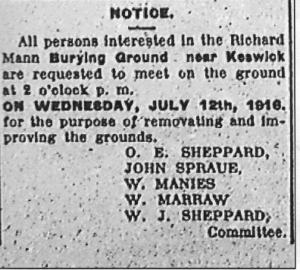 The photo above shows the condition of the Mann Cemetery prior to the formation of the Cemetery Board in 1959. It was charged with the duties of maintaining this and others in the Township. One member of the Cemetery Board was Francis Morton. Francis approached Council as early as 1951 asking that they accept responsibility of cleaning up the Mann Cemetery. This cemetery is now maintained by the Town of Georgina.
The photo above shows the condition of the Mann Cemetery prior to the formation of the Cemetery Board in 1959. It was charged with the duties of maintaining this and others in the Township. One member of the Cemetery Board was Francis Morton. Francis approached Council as early as 1951 asking that they accept responsibility of cleaning up the Mann Cemetery. This cemetery is now maintained by the Town of Georgina.
It is unknown how many burials may be unmarked in this cemetery. The vital information on grave markers was transcribed for the 1971 issue of The York Pioneer. The Ontario Genealogical Society transcribed the complete text of these markers in 1991. The OGS published this transcription and it is for sale on their website. It is recorded as GRG-009 Mann Cemetery. The last burial marked is 1929, Permillia (Thompson) Norton.
Source: This article was used in the Doors Open Georgina: Pefferlaw section of the Doors Open 2010-2013 publication from the library in the offices of the Georgina Pioneer Village.
Editor’s note: Unfortunately not much has changed. Late last fall I visited the Mann Cemetery, and other than occasionally cutting the grass, it was not in a good state. Brush has grown up around fallen stones at the rear of the property and weeds grow rampant there as well.
News & Events
Old-Fashioned Christmas
Here are some photos of several members published in local media taken at the Old-Fashioned Christmas celebration on Saturday, November 24th in the Georgina Pioneer Village. The evening was a resounding success despite the weather.
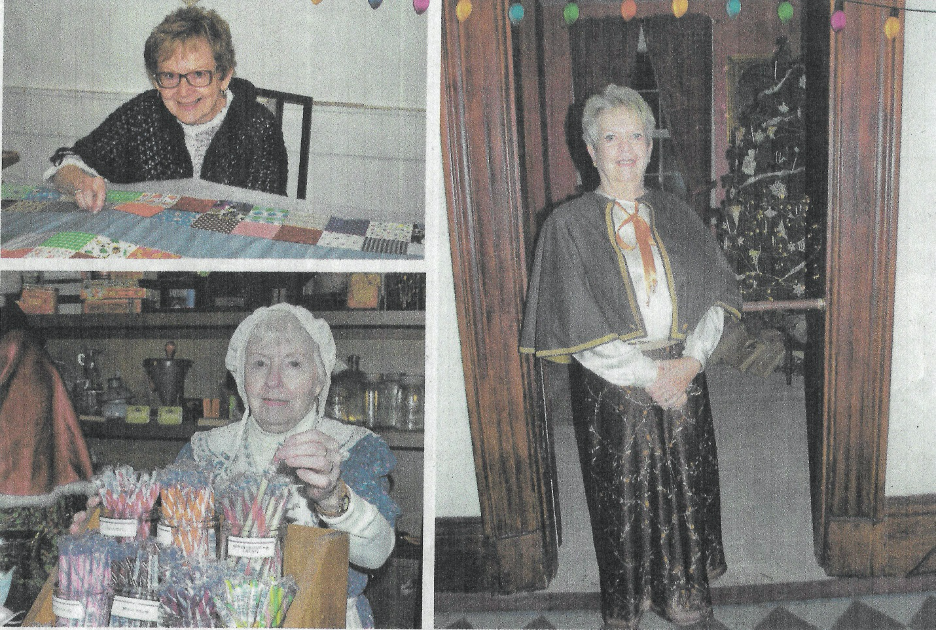
Above left, Estelle LeMaire quilting; lower left. Shirley Illerbrun at the General Store; and Gail Moore our Secretary hosting in the Noble House. Courtesy Voice of the Farmer December 2018
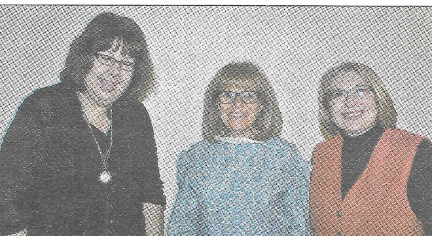
Above, Sandra Dickinson, Andrea Ruth, and Dee Lawrence. Courtesy Snap’d Georgina January 2019, p.2
Board News
Several of our new committees have met and have been very busy. The website committee has met several times and is working hard to bring it up to date. Visit it using the link on our Contact page. The membership and Fund-raising committee has met and is putting together its priorities for th coming year.
A meeting between Melissa Matt and several Board members is paving the way for the Archives Committee. It will be meeting later this month to establish our role in helping to manage that valuable resource. We need the membership to get involved with these committees. Volunteers will be gladly received to help us accomplish the many tasks we ore trying to accomplish.
On February 8th your Board met with Phil Rose-Donahoe and Melissa Matt in the first of several meetings concerning the management and maintenance of the Georgina Pioneer Village.
Together we are trying to determine what resources are needed and where our priorities must lie.
Upcoming Dates
Tuesday, Feb 19th – February General Meeting – presentation on old postcards of Georgina by Tom Glover, Meet & greet 6:30, meeting at the York Regional Police station at 7:00 PM.
Monday, March 4th – March Board Meeting – Noble House, 1:30 PM
Tuesday, Mar 19th – March General Meeting – YR Police, Early Wallpaper Decoration by Sarah Harrison
